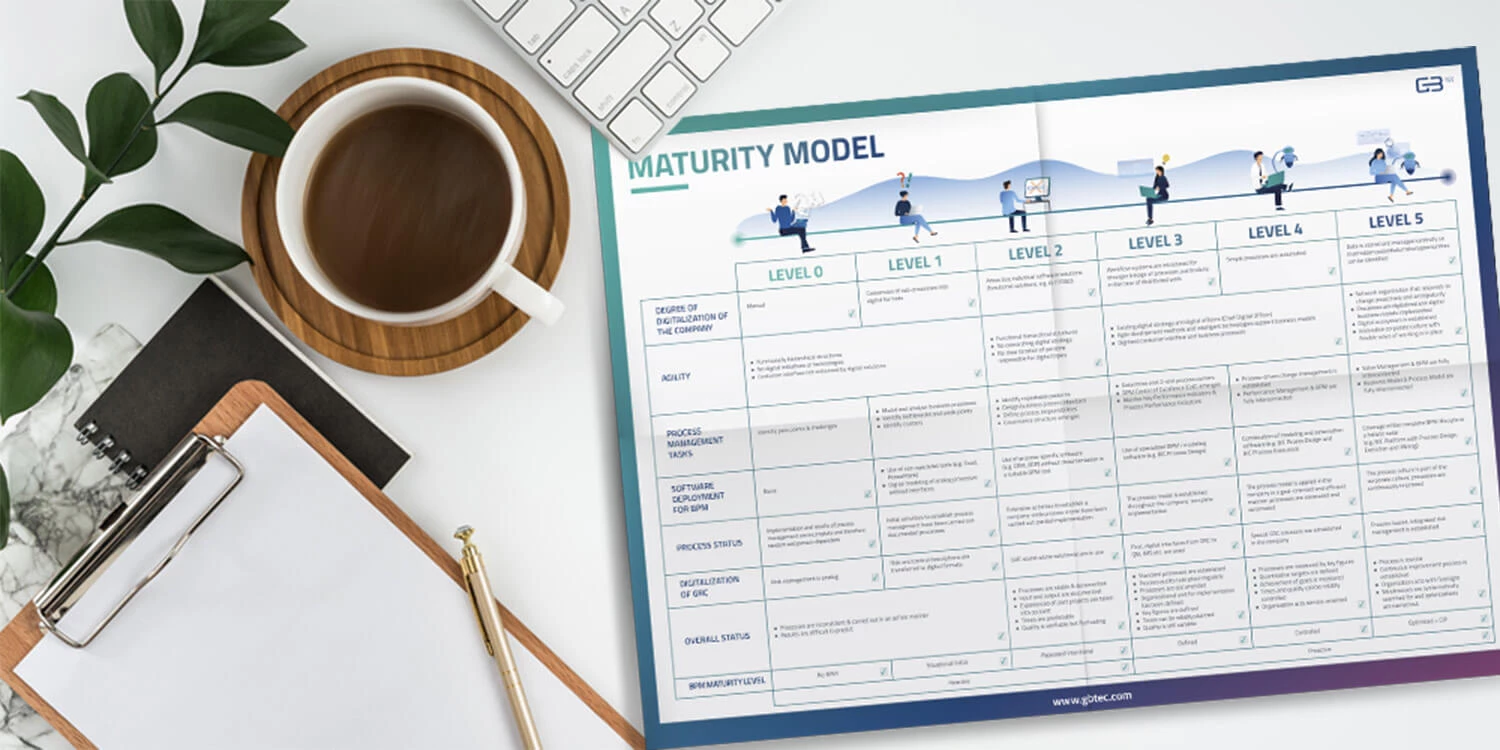BIC Process Design
Understand & Transform
Supercharge your business operations with the most intuitive AI-powered BPM software.
It seems that you come from a German speaking country. Here you can change the language
EnglishWhen it comes to the topic of digital transformation, companies often ask themselves many questions: Where do we stand? How fast is the transformation progressing? What potential do we have and where should we start? Digital maturity models help to answer these and many other questions.


Digital maturity models help companies assess the digital readiness of individual departments or the whole organization. With these models, businesses can evaluate their existing capabilities, identify areas for improvement, and set measures to achieve quality targets. For companies competing globally, it is crucial to assess their capabilities systematically. This ensures they can make changes and improvements that will give them long-term advantages in the market. Using predefined criteria, companies measure the quality of their processes and assign them to a specific maturity level. With such a maturity model, digitalization can also be viewed more comprehensively from the perspective of the entire company, as topics such as resources, channels and the IT infrastructure, as well as aspects such as culture and leadership quality, are included. The higher a digital maturity level is overall, the higher the degree of automation, which is a crucial aspect for digital transformation. Likewise, there is a correlation between the degree of digitalization and the agility of an organization: Companies that respond proactively and anticipatorily to changes, for example, also have extensive automation, a continuous improvement process and an established process culture.
In order to be able to make holistic decisions in the context of digital transformation, companies must understand and illuminate their status quo and consequently all business processes. In this way, scattered competencies can be linked to form an overarching strategy, which increases efficiency and quality in the long term. In the course of determining the degree of digitalization maturity, the dimensions of strategy, customers, products and services, organization and technology should be examined in particular, in addition to the processes. In the following, we will focus on the analysis of digital business processes.
A Business Process Management (BPM) Maturity Model can be used to understand and determine the BPM maturity of an organization. In a next step, targeted recommendations for action can then be developed from this. For a process to be considered mature, its usefulness must be complete, it must be automated, its information must be reliable, and it must be capable of continuous improvement.
Detailed questionnaires can be used to check how close a process is to full maturity. The answers to these individualized questions by management, process owners or process modelers subsequently enable the company to determine the maturity level. In the context of the process analysis, the questions should refer to the individual sub-dimensions of technology, data, quality and organization, as these make up the criteria for operationalization.
Maturity models are very diverse and vary in their holistic nature, which means that their systematic application requires a great deal of experience and expertise. In addition, it must be remembered that each process in the company must be evaluated individually. A large number of processes must be documented, examined and optimized - in large companies, this can take as long as one or two years. However, analyzing the maturity level is undoubtedly worthwhile in order to be able to act holistically and lay a correspondingly good foundation for each next step.
In the context of the process analysis, the questions should refer to the individual subdimensions of technology, data, quality and organization, as these make up the criteria for operationalization. The following criteria must be clarified for each process in order to be able to make a valid statement about the digital maturity level:
Technology
Data
Quality
(Source: Bitkom)
Organization

We have compiled the correlations between the level of digitalization, agility and process management in a graphic that you can download here. The maturity of digitalization as well as that of processes and the agility of an organization is defined here on the basis of six levels, with level 0 representing the lowest maturity and level 5 the highest maturity. While companies in levels 1 and 2 still act reactively, they also become more proactive as their maturity increases. Each maturity level also has a corresponding effect on productivity and risks - as digitalization maturity increases, internal company risks and production costs are reduced due to data-driven and forward-looking actions as well as continuous improvements to business processes.
Depending on how the company classifies itself in the maturity model, the focus of the subsequent tasks also varies. Those in Level 0, 1 or 2 should first sensitize employees and management to digital transformation, develop an overarching digital strategy, provide resources, fully document processes, and complete initial digitalization projects with visible successes. For companies in Level 3 or 4, it is important to implement the existing strategy, measure the processes using key performance indicators and then optimize them to increase quality, and in particular to continue to drive organizational and cultural change. Companies that are already classified as Level 5 should not rest on their laurels, but rather continue to establish the digital ecosystem and actively live the continuous improvement process and an innovative corporate culture.
In any case, digital transformation should be understood more as a journey than a destination - and the digital maturity model as an aid to finding out at which stage of this journey an organization is currently in order to subsequently determine the individual change course toward digitalization.

A digital maturity model makes it easier for companies to objectively assess their processes. The results and conclusions that can be drawn from the use of the model form the basis for target analyses and process improvements as well as the digital transformation process in general. In addition, a comparison with competitors or other company units is made possible.
From the internal perspective of a company, the use of a digital maturity model brings the following benefits:
But there are also benefits for the external view, for example for a potential client:

CEO
Gregor, founder of GBTEC, is a leading expert in Business Process and IT Transformation. For over 20 years, he has been a key figure shaping the BPM world. His passion for designing efficient processes emerged during his studies in business informatics. As the mastermind behind the BIC Platform, Gregor and the GBTEC team develop a comprehensive software suite that covers the entire transformation cycle — from intelligent Business Process Management (iBPM) and Enterprise Architecture Management (EAM) to Digital Process Automation (DPA), Process Mining and Governance, Risk and Compliance (GRC).
We have the information you need to unleash your full process potential. Take a look at our resources and start improving your business performance today.